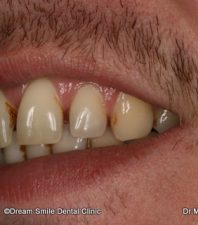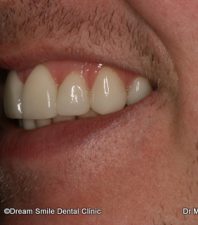E-max veneers side view
Bad Breath

Menu
Otherwise known as halitosis, bad breath plagues millions of people. While its causes are quite common and simple, so is the treatment of it. The food we eat and the bacteria in our mouths are the two main sources of bad breath.
How it works
Back to topSituational Bad Breath: Food as the culprit
Many foods are known to cause bad breath-garlic, onions, and cabbage, just to name a few. Some of these contain sulphur compounds which can cause bad breath. Sulphur compounds are released as the foods are being digested and then travel into the bloodstream and finally the lungs. When we exhale, these smelly compounds are expelled and cause bad breath. Obviously, you can avoid situational bad breath by avoiding these types of foods. If you don’t want to deprive yourself of these foods, you can attack the sulphur compounds using toothpastes and mouthwashes that contain Chlorine Dioxide, which neutralizes the sulphur compounds in your mouth. We have more information about this group of products below, under “Over the Counter Toothpastes and Mouthwashes”.
Regular bad breath: Bacteria as the culprit
There are over 170 different types of bacteria living in your mouth. Not all of them are bad, but some of them are quite destructive. The ones that wreak the most havoc are destroyed by oxygen. Therefore, they hide out in areas that oxygen can’t reach-between the teeth, under the gums, under plaque and food debris, in the biofilm and down deep in the tongue crevices.
These bacteria are the ones that create volatile sulphur compounds (VSC) and cause more routine bad breath as well as cause gingivitis (gum disease). Again, Chlorine Dioxide pastes and rinses neutralize these compounds, thereby ridding you of bad breath and creating a healthier oral environment.
Regular dental hygiene prevents bad breath
Brushing, flossing, using a tongue scraper and mouth rinse can remove the destructivebacteria, remove the protective coating of plaque and food debris and remove the food particles the bacteria feed on.
The biofilm that wraps itself around all your teeth, near and under the gums, can only be removed by your dentist or hygienist. This biofilm is like a sticky nylon stocking that traps bacteria and its compounds and protects them from your toothbrush, floss and mouth rinse. During your hygiene visit, your dentist or hygienist uses an ultrasonic cleaner. This can gently and comfortably disrupt this biofilm and flush it, the bad bacteria and the VSC away.
Can I tell if my breath smells bad?
Since we become accustomed to our own odours, it’s nearly impossible to tell if your own breath smells. Cupping your hands over your mouth and nose and breathing out may not be a viable way to tell if you have bad breath, nor is licking your hand and smelling it. Most of the bad breath is created at the back of your mouth and pushed out while you are talking.
If it’s too embarrassing for you to ask a trusted friend or loved one if your breath smells, you can always ask your dentist or hygienist. She can tell if you are at risk and what can be done to help you.
Just brushing and flossing may not alleviate bad breath. Your tongue is like a carpet with many fibres on its surface. Dr. Tehranian explains to his patients that these fibres get matted down with food particles and bacteria and their by-products. Almost half of the oral bacteria hang out in this safe area. If you’ve ever had your home carpets professionally cleaned, you know the first thing the cleaners do is rake the carpet to stand all the fibres up. Once they’ve done that, they will shampoo the carpet, knowing it will reach to the base of the carpet.
A tongue scraper works the same way on your tongue carpet. Using this before you brush and floss will stand up the tongue fibres, remove much of the bacteria and its by-products and then make it easy to clean your tongue with your toothbrush and paste. What you will scrape off is a whitish layer of bacteria, plaque, and food debris. This simple procedure can greatly improve the condition of your breath.
Dry Mouth Prevention
There are many conditions that contribute to dry mouth. Many medications, like high blood pressure meds, anti-anxiety, anti-depressants and chemotherapy, can cause saliva flow to decrease, sometimes dramatically. Besides being uncomfortable, decreased saliva flow puts you at greater risk for cavities, gum disease and bad breath.
Alcohol consumption, smoking, breathing through your mouth, dieting, fasting and talking for long periods of time can also contribute to bad breath. In all of these cases, frequent sips of water can help wash away the bad bacteria, dilute and remove VSC and keep your mouth moist. Reduction in saliva flow is the main cause of “morning breath”.
Many breath mints work more so because they stimulate saliva flow rather than just cover up breath odours. Tart mints, like lemon or other citrus-flavoured ones, work especially well to stimulate saliva flow. Chewing sugarless gum is a fairly good option after a meal if you cannot brush your teeth right after. Many gums and mints now contain xylitol, a sugar substitute, which has been shown to prevent tooth decay by creating an inhospitable oral pH for cavity-forming bacteria.
Over-the-Counter Toothpastes and Mouthwashes
Most over the counter toothpastes and mouthwashes work by moving the bacteria and its compounds around, not by actually eliminating them. Many over the counter mouthwashes have a high alcohol content that can worsen the situation since alcohol dries out your mouth. 10-20 minutes after rinsing, you may notice your bad breath has returned, sometimes even more aggressively.
Chlorine Dioxide toothpastes, mouthwashes and breath sprays are very effective in treating bad breath. Chlorine Dioxide is an oxygenating compound, thereby creating a hostile environment for the bad breath bacteria and neutralizing the VSC compounds that cause gum disease and bad breath. There are a number of brands available over the counter. Dr. Tehranian has tried them all and she prefers the Ultra-Dex.
Postnasal Drip
Allergies, common colds, hormonal changes, medications and pregnancy can create a thick nasal discharge. If this mucus constantly drips down the back of your throat, it can build up on the back of your tongue, getting caught in all those fibers. This mucus coating then covers and protects the bacteria that cause bad breath, in addition to serving as a food source for them.
Bad Breath caused by Gum Disease
If you avoid odour-causing foods, frequently clean your teeth, gums and tongue, keep your mouth moist and you still have bad breath, it may be a sign of something more sinister. Gum disease (gingivitis) and periodontal disease (periodontitis) are major causes of bad breath.
Normally there is a small gum pocket around your teeth. This pocket, when healthy, measures about 1-3 mm deep. Gingivitis and periodontitis patients often have pockets deeper than 3 mm. The deeper the pocket, the greater the space where the bacteria can hide. Any pocket deeper than 3 mm is nearly impossible for you to keep clean using only your toothbrush and floss. That means the majority of bacteria living in pockets deeper than 3 mm are never disturbed or destroyed. These bacteria are the ones who create the Volatile Sulphur Compounds previously mentioned that cause bad breath and gum disease.
Other symptoms associated with periodontal disease include:
- Swollen or bleeding gums
- Tender gums
- Loosening and shifting teeth
- Sensitive teeth
- Pain when you chew
- Pus or discharge from the gums
It’s now known that untreated periodontal disease puts you at greater risk for heart disease, stroke, diabetes and low birth weight babies. Call or email Dream Smile Dental Clinic for your periodontal exam and cleaning. It may not only save your breath and your teeth; it could save your life.




